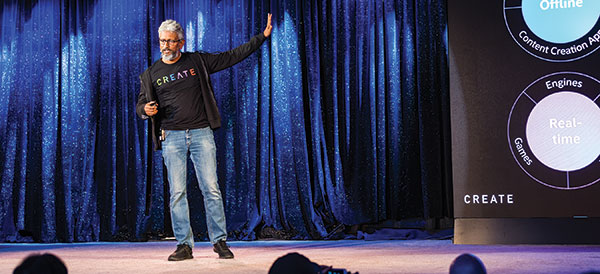Getting Graphic
Intel is joining the discrete GPU market. Here’s how to follow the latest news and announcements from the chipmaker.

At SIGGRAPH 2019, Raja Koduri, Intel chief architect and senior vice president, Architecture, Software and Graphics, discussed the importance of exascale computing, which will unlock new opportunities for fast rendering, physical simulations and new artificial intelligence supported workflows. Image courtesy of Intel.
Latest News
December 1, 2019
Anyone who follows the computing industry has heard that Intel is getting into the graphics game. It’s kind of a big deal. To graphics processing unit (GPU) leaders AMD and NVIDIA, Intel’s announcement is the equivalent of Tesla hearing that General Motors is going all in on electric cars. With revenue and employee head count roughly seven times that of either company, it’s clear that Intel could be the elephant in the graphics room for years to come.
Focus on Edge Computing
November 8, 2017, might prove to be the day that everything changed for GPU manufacturers everywhere. Recognize the date? Raja Koduri sure does. That’s the day he left his job as senior vice president and chief architect of the Radeon Technologies Group at AMD and joined Intel, where he now serves as the chief architect and senior vice president of the company’s new Core and Visual Computing Group.
He’s also leading Intel’s corporate push into edge computing solutions. According to the press release announcing his decision to join Intel, Koduri’s new responsibilities would “expand Intel’s leading position in integrated graphics for the PC market with high-end discrete graphics solutions for a broad range of computing segments.”
What does it all mean? There’s speculation galore out there, but hard facts are less forthcoming. Based on the press release and comments by Dr. Murthy Renduchintala, Intel’s chief engineering officer, we know that they’ve hired “one of the most experienced, innovative and respected graphics and system architecture visionaries in the industry.”
And according to Agnes Kwan, a member of Intel’s Global Communications team, the press release also includes Intel’s plan to “gradually introduce products across the consumer, workstation and data center markets at various price points.”
The Odyssey Continues
That time is rapidly approaching. A tweet from @intelnews in June of 2018 said, “Intel’s first discrete GPU coming in 2020” then offered a link back to the press release, which said nothing about 2020 or any potential GPU time frames. However, Intel CEO Bob Swan announced on October 25 that, “This quarter, we’ve achieved power-on exit for our first discrete GPU, DG1, an important milestone…#JoinTheOdyssey.”
If you’re wondering what “power-on exit” means, it refers to the initial in-house product testing. It signifies that Intel has the GPU goods, they work as designed and project engineers are moving on to the next milestone, which most pundits suggest is external testing.
And if you’re wondering what or who “The Odyssey” is, you can think of it as Intel’s “graphics and visual computing” fan club, a community that is actively recruiting members as the company moves toward its planned GPU-based gaming and workstation graphics dominance.
Architecture Day and Beyond
Details are still unknown on the actual GPU, though, and what users can expect in terms of speed, footprint and integration with software providers. Intel’s last “Architecture Day” in December 2018 announced several exciting developments, including an industry first in packaging technology, the “3D stacking of logic chips” that Intel has named Foveros.
There was also news of the company’s new Sunny Cove next-generation CPU microarchitecture, a quad-core Ice Lake processor with integrated Gen11 graphics capabilities (>1 TFLOPS performance), and the latest in Intel’s Optane DC persistent memory, said to significantly reduce read latency when processing “bigger data sets like those used in AI and large databases,” according to Intel press.
Unfortunately for GPU followers, though, the only mention in the post-event press release was in the context of Intel’s “‘One API’ Software,” which promises to “simplify the programming of diverse computing engines across CPU, GPU, FPGA [field-programmable gate arrays], AI [artificial intelligence] and other accelerators” and be made available in 2019, according to Intel.
A more meaningful clue came from Intel’s annual investor meeting in May, during which Intel’s Renduchintala, who is group president of the Technology, Systems Architecture and Client Group, said that “the lead 7nm product is expected to be an Intel Xe architecture-based, general-purpose GPU for data center AI and high-performance computing. It will embody a heterogeneous approach to product construction using advanced packaging technology. On the heels of Intel’s first discrete GPU coming in 2020, the 7nm general-purpose GPU is expected to launch in 2021.”
SIGGRAPH 2019
Perhaps the most relevant of all news for “creators and workstation users,” according to Intel’s Kwan, came from Intel’s CREATE event at SIGGRAPH 2019. Here, the company discussed recent advancements that included their vision of democratizing creation by bringing exascale computing to everyone, along with another mention of its oneAPI Rendering toolkit.
“I’m deeply passionate about this future opportunity and have challenged my teams to pursue a goal of 1,000 times performance advancement over the coming years to enable this,” says Intel’s Koduri.
(Attendees at HPC DevCon in November in Denver, CO, will have heard Koduri’s keynote speech about Intel’s “vision, strategy and upcoming technology roadmap across hardware and software to further accelerate the convergence of HPC and AI and push the boundaries of HPC as we know it today.” As this issue went to press in advance of the event, it’s unclear as of this writing if there was any mention of GPUs.)
Here’s one final source for those of you following the Intel discrete GPU saga. It’s the @IntelGraphics Twitter, where Swan of Intel tweeted about the whole power-on exit technology. Kwan said it’s a good source for product announcements and community chatter, much of which mentions GPUs and other graphics-related news. Happy following.
More AMD Coverage

More Intel Coverage
More NVIDIA Coverage
Subscribe to our FREE magazine, FREE email newsletters or both!
Latest News
About the Author
Kip Hanson writes about all things manufacturing. You can reach him at .(JavaScript must be enabled to view this email address).
Follow DERelated Topics






